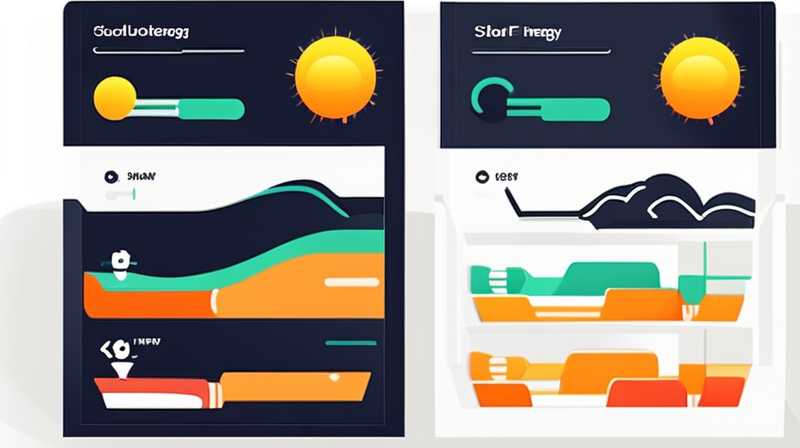
To check the new solar energy output, it’s essential to utilize various methods and tools tailored specifically for monitoring solar performance. 1. Utilize performance monitoring software or apps, 2. Inspect the inverter readouts, 3. Conduct regular system maintenance and cleaning, 4. Track weather conditions for accurate performance metrics. One of the pivotal points involves leveraging performance monitoring software or applications. Such platforms provide real-time data, allowing users to assess how much power their solar panels generate. By analyzing this data, users can identify patterns and variations in energy output at different times, optimizing their energy consumption and addressing any potential issues promptly.
1. THE IMPORTANCE OF MONITORING SOLAR PERFORMANCE
Solar energy systems represent a significant investment, and as such, understanding their output is essential. Monitoring ensures that users are receiving the optimal return on their investment. Regular assessment of solar energy performance not only provides valuable insights but also informs users of any potential complications. An efficient monitoring system can significantly enhance the effectiveness of energy production.
When assessing solar power output, it is crucial to consider efficiency. Solar panels do not operate at 100% efficiency; various factors influence their performance. Weather conditions, shading from nearby trees or buildings, and panel orientation can lead to fluctuations in energy production. Therefore, establishing a routine that incorporates performance checks will yield better energy management and cost savings.
2. PERFORMANCE MONITORING SOFTWARE AND APPS
One of the most effective approaches for tracking solar energy output involves the utilization of performance monitoring software or mobile applications. These tools typically interface with solar inverters, collecting data on energy production, consumption, and system efficiency. Users can access real-time performance metrics, historical data, and even alerts for system malfunctions.
An advantage of employing performance monitoring solutions is the accessibility of information through mobile devices. Users benefit from the convenience of monitoring anywhere and anytime, provided they have internet connectivity. This immediate access ensures that users can react swiftly to any deviations from expected performance, facilitating proactive maintenance and adjustments.
3. INSPECTING INVERTER READOUTS
Another critical aspect of checking new solar energy output includes careful examination of inverter readouts. Inverters play a vital role in converting direct current from solar panels into the alternating current used in households. They often feature a digital display or integrated communication system that showcases performance statistics.
Understanding the readouts from inverters is essential since they provide insights into energy production, consumption, and overall system health. Regularly checking these statistics can reveal underperformance or system anomalies. By correlating inverter data with performance benchmarks, users often identify opportunities for enhancement, ensuring maximum energy output efficiency.
4. REGULAR SYSTEM MAINTENANCE AND CLEANING
Maintaining solar panels in optimal condition is pivotal for ensuring efficient energy production. Dust, dirt, and debris accumulation can severely impact solar output. Therefore, regular cleaning and maintenance of the solar panels are imperative to sustain maximum energy efficiency.
Regularly inspecting solar panels for any physical damage or obstructions can play a critical role in performance maintenance. Establishing a routine that involves inspections often enables users to find issues before they become significant problems. Additionally, understanding the landscape surrounding the solar array helps manage potential shading impacts.
5. TRACKING WEATHER CONDITIONS
Weather conditions significantly influence solar energy performance. Factors such as cloud cover, precipitation, and temperature can alter the output of solar panels. Tracking weather data allows for a more nuanced understanding of how external conditions impact energy generation.
For example, prolonged cloudy conditions may lead to lower energy production compared to sunny days. Understanding these weather patterns allows users to adjust their energy consumption accordingly. Moreover, it can help in strategizing maintenance tasks, ensuring that panels are cleaned after storms or heavy dust periods to retain optimum operation.
FAQs
HOW CAN I MONITOR MY SOLAR ENERGY OUTPUT EFFECTIVELY?
Monitoring solar energy output effectively involves utilizing a combination of performance monitoring apps, checking inverter readouts, and regular inspections. Performance monitoring software provides real-time data, while inverter readouts offer insights into energy production and health. Moreover, routine inspections ensure cleanliness and detect potential issues early in the process.
WHAT FACTORS AFFECT SOLAR ENERGY OUTPUT?
Multiple factors affect solar energy output, including weather conditions, panel orientation, shading from nearby objects, and overall system maintenance. Weather patterns like overcast skies can diminish output, while physical obstructions can lead to significant reductions in energy production. Maintaining optimal panel conditions and positioning is essential for maximizing solar efficiency.
HOW OFTEN SHOULD I CLEAN MY SOLAR PANELS?
The frequency of cleaning solar panels largely depends on their location, local weather, and environmental conditions. As a general guideline, panels should be cleaned at least once or twice a year. However, if you reside in a particularly dusty area or experience heavy bird activity, more frequent cleaning may be necessary to maintain efficiency.
In essence, the process of checking output from solar energy systems requires an integrated approach that involves various strategies and tools. Monitoring performance through software and apps aligns with gaining real-time insights, ensuring users maintain efficiency and maximize their energy output. Additionally, scrutinizing inverter readouts enhances users’ understanding of energy production and system health, facilitating informed decision-making. Regular maintenance is equally crucial as it contributes to sustaining optimal performance levels. Furthermore, recognizing the impact of environmental factors allows users to strategize their energy management effectively, adapting their consumption patterns to align with expected production.
Ultimately, a well-monitored solar energy system not only represents a wise investment but also significantly contributes to sustainable energy practices. Educating oneself about the intricacies of solar energy generation and output empowers users to make informed decisions. By embracing both technology and maintenance practices, users can ensure that their solar panels operate efficiently over the long term. This holistic approach to solar monitoring and management underpins a successful transition to renewable energy, reinforcing both environmental sustainability and economic benefits for users invested in solar technology. A fruitful experience with solar energy begins with diligent monitoring, comprehensive understanding, and proactive maintenance.
Original article by NenPower, If reposted, please credit the source: https://nenpower.com/blog/how-to-check-the-new-solar-energy-output/


